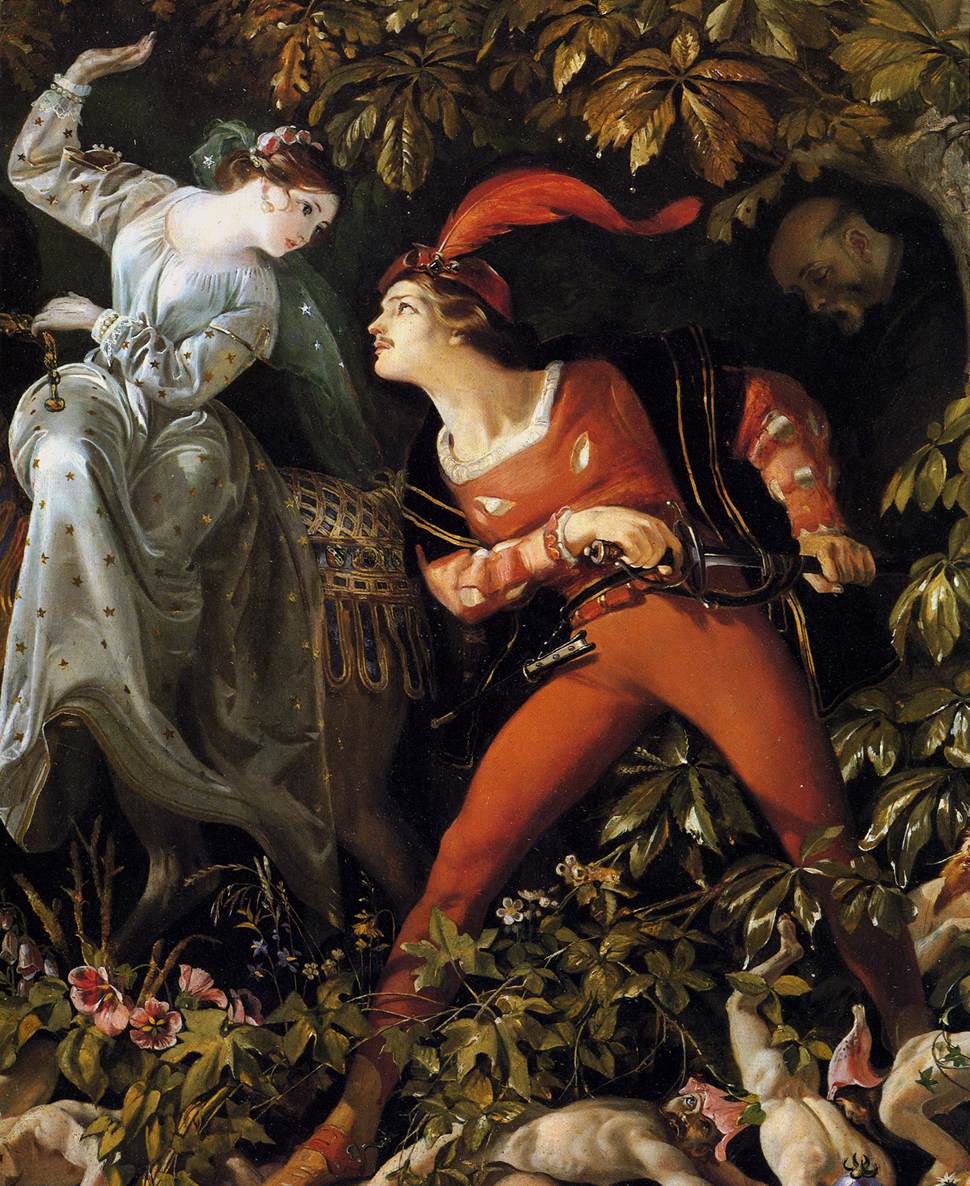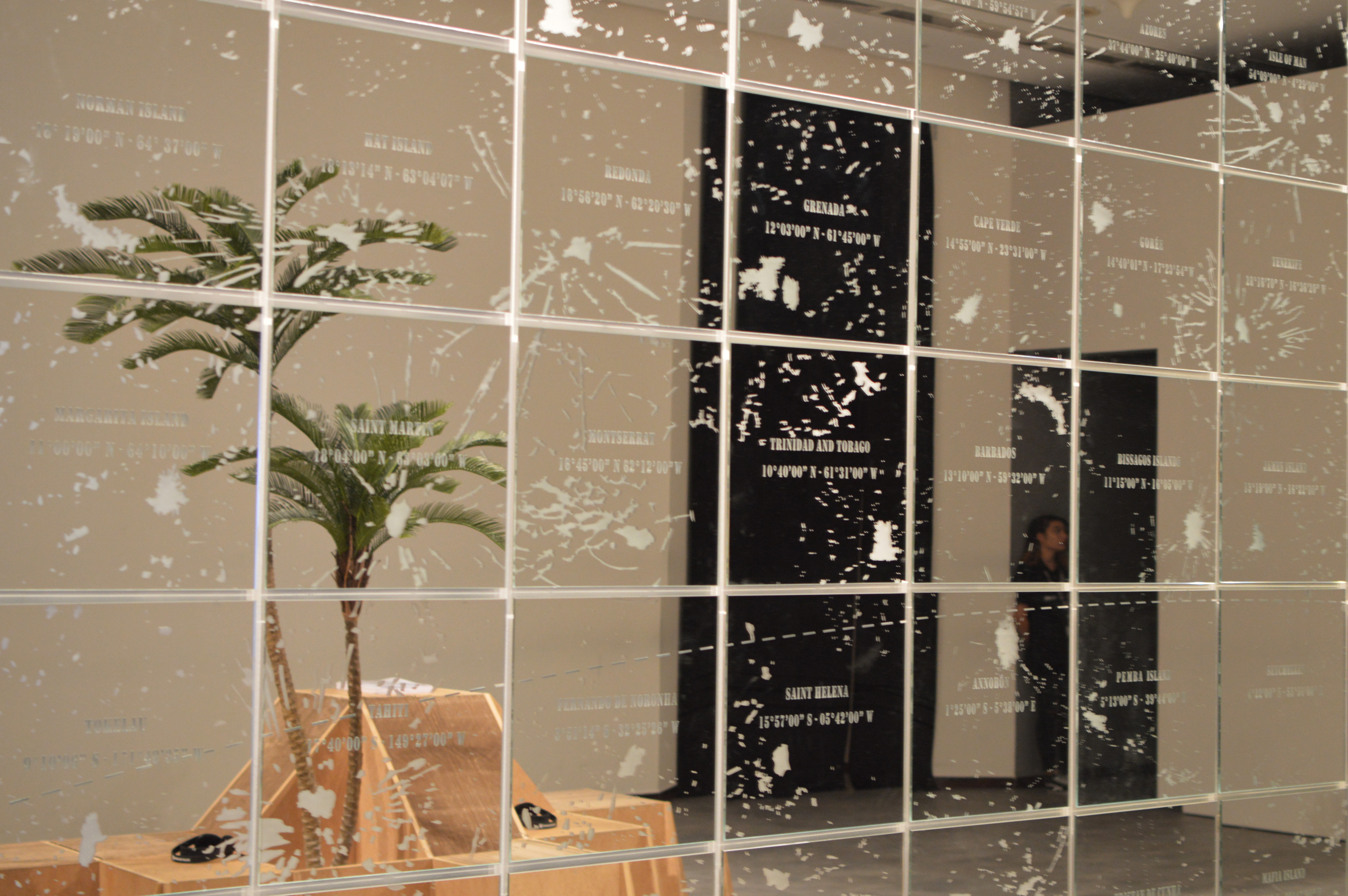
Features
Discovering The Atlas at The Singapore Biennale
By Karel Tan
As Singapore enters the 5th edition of the Biennale, we can sense its maturity in its curation and theme. Named, “An Atlas Of Mirrors”, this year's event breaks away from past themes of exploration and wonder to a more contemplative theme, questioning our perspective of the world and the position that we stand in after the many events that united us in the same space. We spent an afternoon at the Singapore Arts Museum to catch up with the event, and came away with many reflections and thoughts about our past, present and future.

Map Office, Desert Islands
Each panel of glass contains the etching of individual islands, yet are arranged such that each piece appears to form one mirrored map. We like the natural setting of the room, allowing us to experience the idyllic environments we usually associate with islands. As we sit on the tiny cardboard island in the middle of the room, we hear the snippets of news reports and radio clips that brings us to the histories, conspiracies and sceneries of each island. These are islands that can be overlooked in size, but as we listen in and gaze at the mirrored map, we begin to realise the momentous impact that each plays in the world, be it economically, socially or politically. It is just like our island; though small in size, we have made waves as a big influence in the economy and tourism industry in Asia.
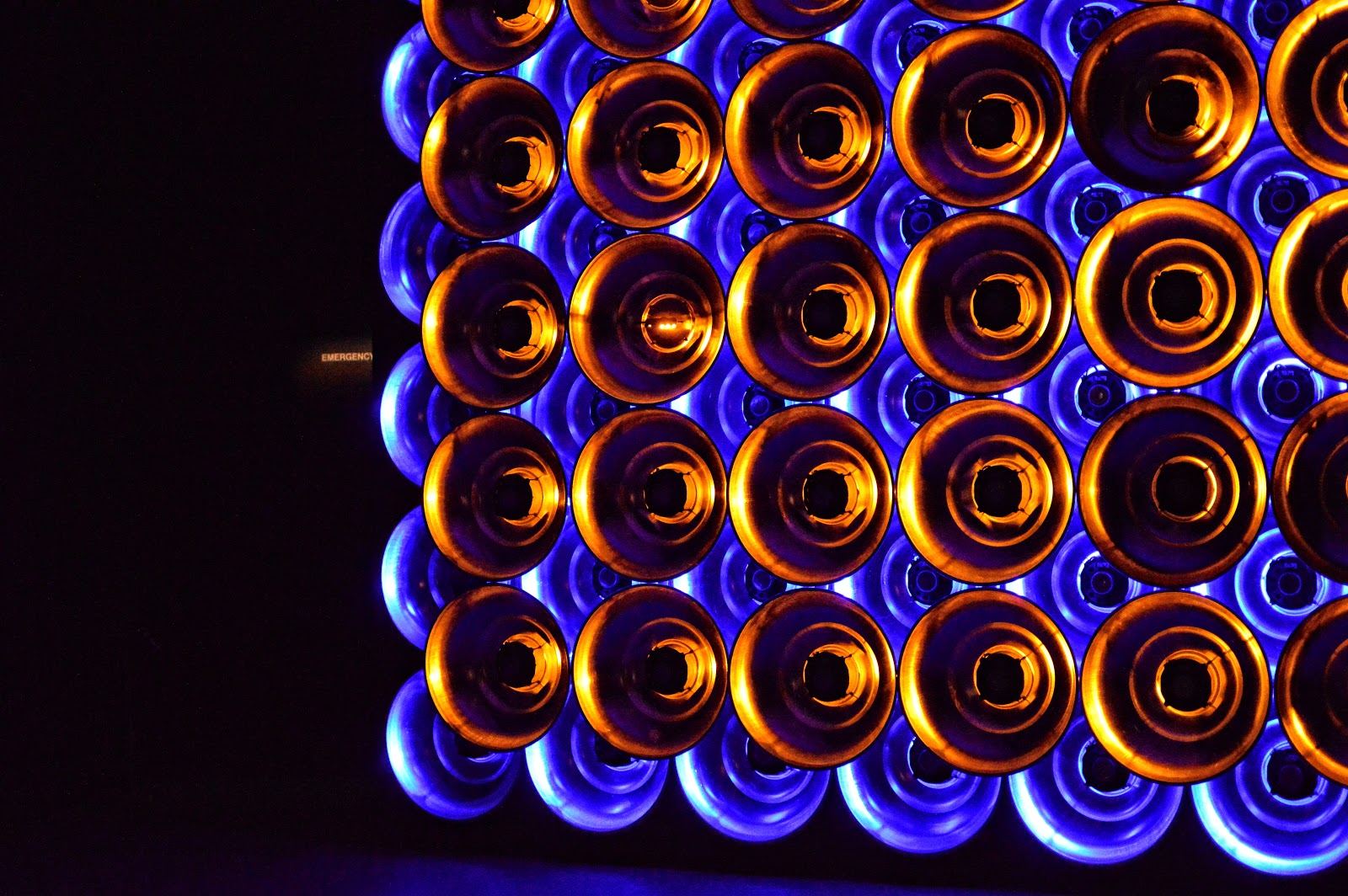
Zulkifle Mahmod, SONICreflection
What is in a place, the sights, smells or the sounds? Zulkifle Mahmod’s challenges us in the way we perceive the landscape by replacing visuals with the ambience of the place. The wok lids, a household item used widely amongst the cultures in Singapore, creates a humanising trait that allows us to relate to the voices captured in the audio. Sitting in the dark as we watch the neon lights brighten and dim to the sounds, the work appears to mimic the transition of day and night, allowing us to feel the elapse of time that endears us to the audio instead of making us the mere listeners of sound. The work succeeds in creating a lasting impression on us long after we left, leaving us to ruminate over the overlooked importance of the incorporeal that carries the character of each place more closely than its visual impression.

Harumi Yukutake, Paracosmos
The name of the work speaks for itself: a universe of parallel worlds. We found ourselves momentarily disoriented as we climb up the staircase, eradicating our sense of reality and illusion as we find ourselves everywhere, yet nowhere. It aligns perfectly with the philosophical concept of Michael Foucault, throwing us into a heterotopia, where the layers hiding in the background come to light. Though the images in the mirrors may be illusory, it reveals the many perspectives we can relate to look at ourselves, just like the many possibilities that we can look at or act upon our reality. It is disconcerting to look at, yet no one can really discern the emotions created as good and bad. The philosophy behind the work is, after all, a question thrown at our perceptions of the world and our lives.


Dex Fernandez, I Wander, I Wonder
Each mural focusing on one or two characters, we feel as though the objects are painting portraits of their stories; void of semantic logic, but in an intimate manner that we cannot describe entirely. Dex Fernandez investigates the sentimentality that we hold in impractical objects, choosing subjects who survived natural disasters and Filipinos working in Singapore as his focus for his art. Influences of pop art allows a more informal tone, engaging us in a more personal dialogue with his characters. We found ourselves reflecting on our own collections of ‘useless’ things as we look upon theirs; even I have a box filled with memorabilia from my childhood. We know that these objects do not serve any functional purpose in our lives, yet they feel as though they are a crucial part of us. Somehow, to us and to the people depicted in his work, the objects form a portrait of our characters and the stories that lie behind each one. The work balances the relaxed visuals and concepts wonderfully, allowing the mood and concept to reach us almost instantly.

Pala Pothupitiye, Other Map Series
Maps are the key to charting courses to new lands, and ultimately charting the course of History. Pothupitiye’s works take the purpose of maps to another level, incorporating historical and mythical figures that define Asia’s past and present. There are dark undertones in his works, appropriate for the unrest and colonization that once dominated parts of the region. However, there are elements of comicality and mysticism that stand out, bringing us to wonder at a different history and outcome that could have been realized if events has turned out differently. We feel that the concept is intriguing, but that some of his works may appear too cluttered for the idea to come through cleanly. It may be due to the bar-codes scattered in the background like in the work above, and an element which hints at an underlying message. Bar-codes could refer to individuality amongst the nations; after all, bar-codes are never exactly the same. However, it could also refer to the capitalism that poses to rewrite the way we live and the borders of our countries. We leave it to you to form your own deductions of this mystery.
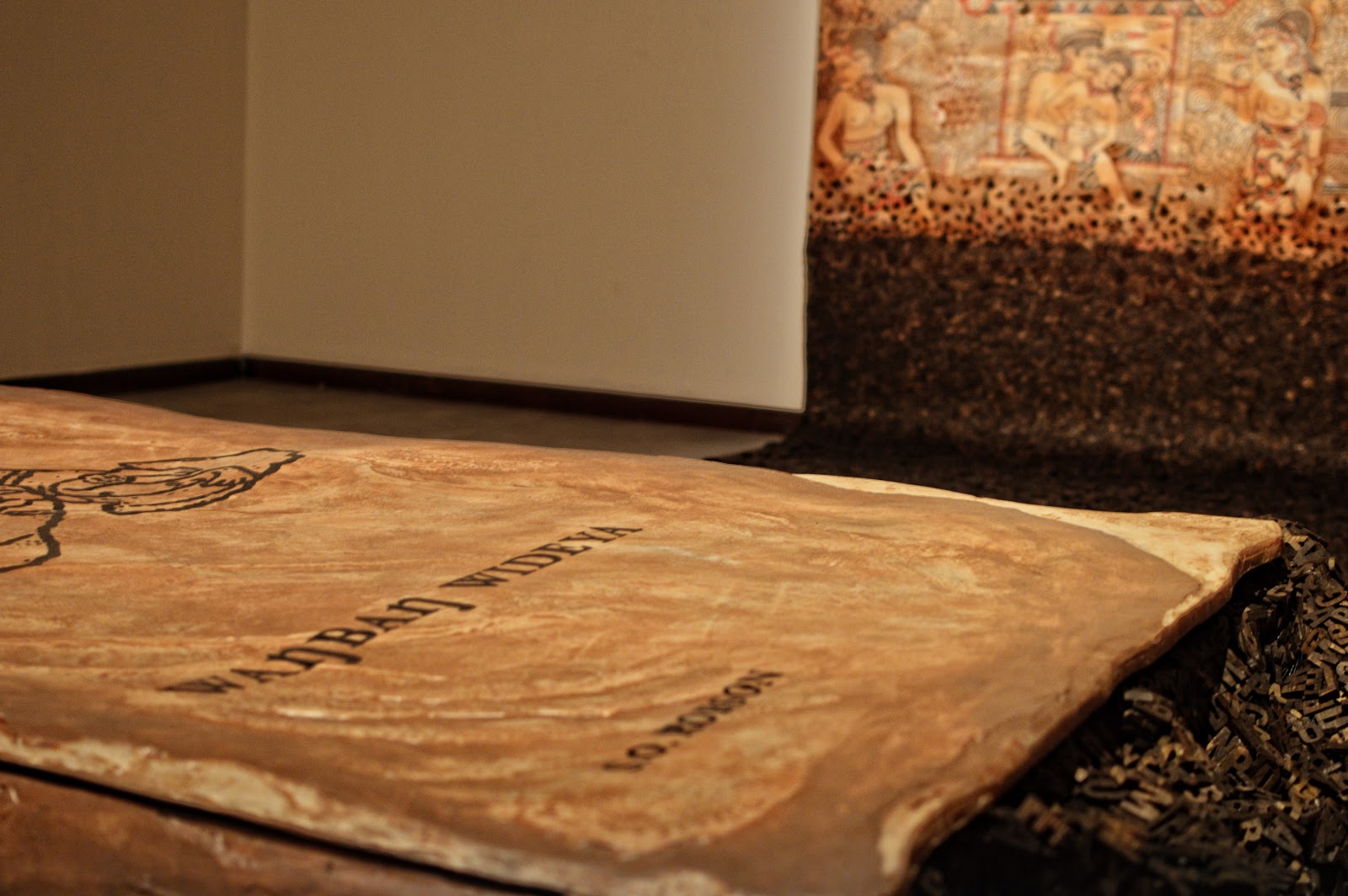
Eddy Susanto, The Journey of Panji
Map Office, Desert Islands
Each panel of glass contains the etching of individual islands, yet are arranged such that each piece appears to form one mirrored map. We like the natural setting of the room, allowing us to experience the idyllic environments we usually associate with islands. As we sit on the tiny cardboard island in the middle of the room, we hear the snippets of news reports and radio clips that brings us to the histories, conspiracies and sceneries of each island. These are islands that can be overlooked in size, but as we listen in and gaze at the mirrored map, we begin to realise the momentous impact that each plays in the world, be it economically, socially or politically. It is just like our island; though small in size, we have made waves as a big influence in the economy and tourism industry in Asia.
Zulkifle Mahmod, SONICreflection
What is in a place, the sights, smells or the sounds? Zulkifle Mahmod’s challenges us in the way we perceive the landscape by replacing visuals with the ambience of the place. The wok lids, a household item used widely amongst the cultures in Singapore, creates a humanising trait that allows us to relate to the voices captured in the audio. Sitting in the dark as we watch the neon lights brighten and dim to the sounds, the work appears to mimic the transition of day and night, allowing us to feel the elapse of time that endears us to the audio instead of making us the mere listeners of sound. The work succeeds in creating a lasting impression on us long after we left, leaving us to ruminate over the overlooked importance of the incorporeal that carries the character of each place more closely than its visual impression.
Harumi Yukutake, Paracosmos
The name of the work speaks for itself: a universe of parallel worlds. We found ourselves momentarily disoriented as we climb up the staircase, eradicating our sense of reality and illusion as we find ourselves everywhere, yet nowhere. It aligns perfectly with the philosophical concept of Michael Foucault, throwing us into a heterotopia, where the layers hiding in the background come to light. Though the images in the mirrors may be illusory, it reveals the many perspectives we can relate to look at ourselves, just like the many possibilities that we can look at or act upon our reality. It is disconcerting to look at, yet no one can really discern the emotions created as good and bad. The philosophy behind the work is, after all, a question thrown at our perceptions of the world and our lives.
Dex Fernandez, I Wander, I Wonder
Each mural focusing on one or two characters, we feel as though the objects are painting portraits of their stories; void of semantic logic, but in an intimate manner that we cannot describe entirely. Dex Fernandez investigates the sentimentality that we hold in impractical objects, choosing subjects who survived natural disasters and Filipinos working in Singapore as his focus for his art. Influences of pop art allows a more informal tone, engaging us in a more personal dialogue with his characters. We found ourselves reflecting on our own collections of ‘useless’ things as we look upon theirs; even I have a box filled with memorabilia from my childhood. We know that these objects do not serve any functional purpose in our lives, yet they feel as though they are a crucial part of us. Somehow, to us and to the people depicted in his work, the objects form a portrait of our characters and the stories that lie behind each one. The work balances the relaxed visuals and concepts wonderfully, allowing the mood and concept to reach us almost instantly.
Pala Pothupitiye, Other Map Series
Maps are the key to charting courses to new lands, and ultimately charting the course of History. Pothupitiye’s works take the purpose of maps to another level, incorporating historical and mythical figures that define Asia’s past and present. There are dark undertones in his works, appropriate for the unrest and colonization that once dominated parts of the region. However, there are elements of comicality and mysticism that stand out, bringing us to wonder at a different history and outcome that could have been realized if events has turned out differently. We feel that the concept is intriguing, but that some of his works may appear too cluttered for the idea to come through cleanly. It may be due to the bar-codes scattered in the background like in the work above, and an element which hints at an underlying message. Bar-codes could refer to individuality amongst the nations; after all, bar-codes are never exactly the same. However, it could also refer to the capitalism that poses to rewrite the way we live and the borders of our countries. We leave it to you to form your own deductions of this mystery.
Eddy Susanto, The Journey of Panji
Here we witness the trans-formative power that cultures have on stories and legends. The ambient lighting and earth colors of his works makes us feel as though we are stepping into the pages of a historic book. Susanto’s work centers on a collection of stories portraying the life of Prince Panji, a legendary prince from Java. These stories have since transformed and melded, just like our identities in Southeast Asia today; how we may have common roots, but have become so boundless in our transformation and outreach that we form our unique individuality. The letters spilling out of the book makes for an interesting metaphor, as though the letters have taken personalities of their own and trying to escape and live out their own lives. His work encourages an appreciation of a new kind of beauty that is not limited to a singular source, but amplified by the different perspectives we have. Additionally, it makes us wonder as we admire the work with strangers standing by. What are the stories that we could have in common with them? How similar can our roots be? We would say that the work poses a paradoxical perspective, embracing individuality while showing a moment of unity in our beginnings.

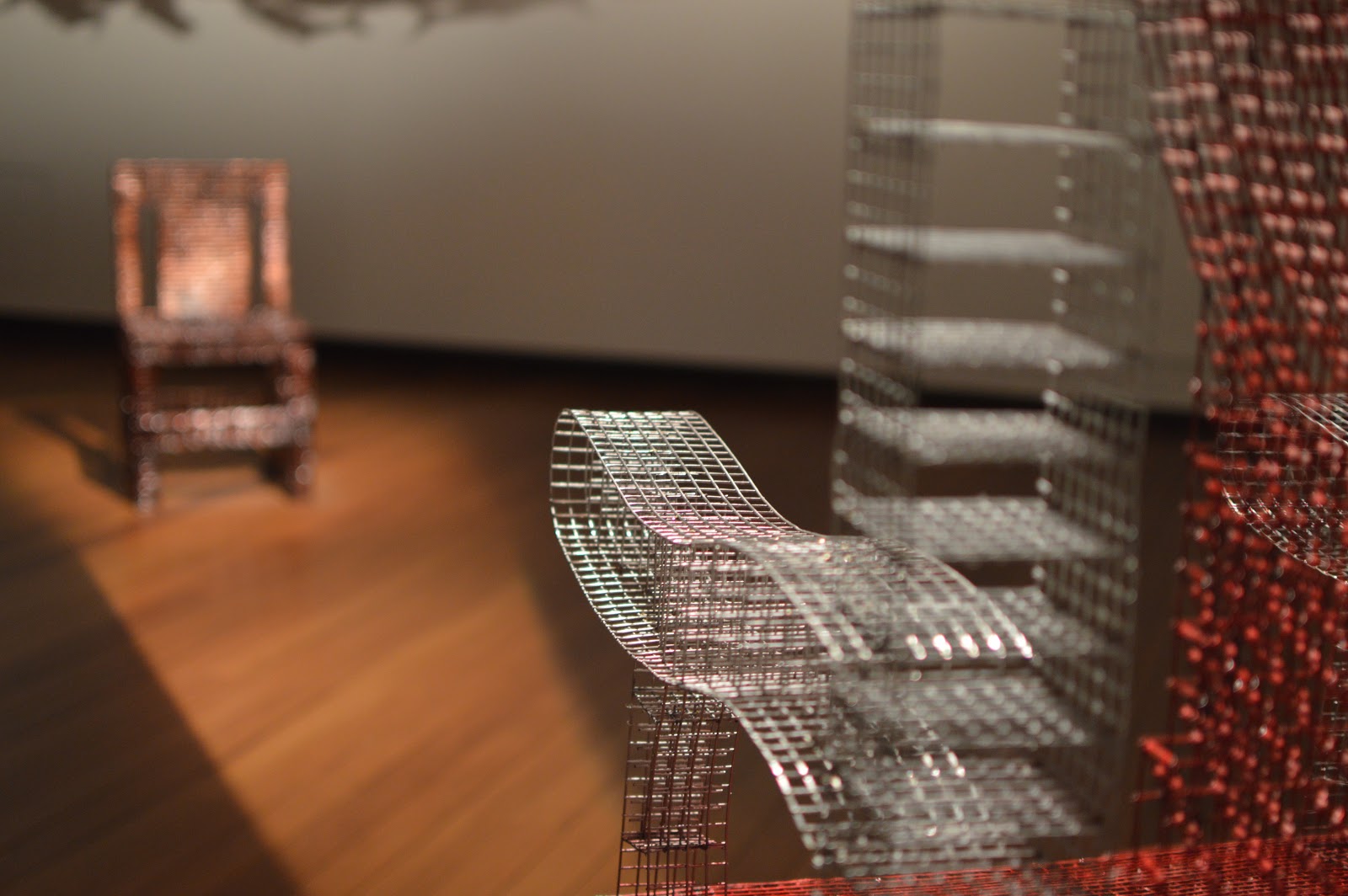
Sharmiza Abu Hassan, The Covenant
As we read the synopsis of the next work, we realize the clever shadow play that imbues the darkness lurking in the legend that the work is based on. The legend is familiar to most Singaporean viewers; A man who saved our country from a vicious swordfish attack, only to be murdered by its ruler in return. We feel that the suspended sculpture perfectly casts the metaphor of chaos and confusion that could have ensued from such peril. The throne chair casts an oppressing light onto the ordinary chairs, reflecting the disconcerting balance of hope and dominance in the ruler’s reign. There is a pulsating tension throughout the room, a perfect reflection of the story’s iniquitous ending. Was that the power that the ruler relished when he ordered the hero’s death? Was the murder only an expression of prideful dominance? We are left to wonder at the possibility of conversation between ruler and citizen, and the emotions swirling round the room as the ruler announces his death.

Titarubi, History Repeats Itself
We are instantly taken aback at the ghostly appearance of these hooded figures as we stare into the dark room. Like ornately-dressed messengers of death, they stand sentient atop burnt-out boats, creating an unsettling atmosphere that looms over the installation. Titarubi’s installations is a visual take of Southeast Asia’s colonial history, choosing to focus on the dark realities that the old colonial masters leave in their wake. Nutmeg was an important spice that became a catalyst of numerous wars fought between the colonial masters. By choosing to coat nutmeg seed gold for the cloaks, he displays the meaningless pursuit of riches, a concept that continues to be relevant to us today. The world today still fights for domination, wealth and power, but at what cost? We should have learned from our history, yet we still see such strife in the news and our lives. Are we fated to witness these tragedies forever? The installation fires harsh questions upon our reality, generating an unshakable impact which persists after we leave the room.

Deng Guoyuan, Noah’s Garden II
Stepping into the kaleidoscopic garden is a welcome break from the heaviness created by the previous rooms. Adopting a neon palette, the colors of Guoyuan’s strange plants are strong, sometimes painfully bright to look at under the cool lighting. On closer inspection, we realize the plants to emulate similar depictions in traditional Chinese art. Blending the old and the new together, Guoyuan creates a universe not far from the future, one that incites hope and change, and also skepticism at such a realization. We wonder at the strange beauty of the mirrored gardens that made sense despite the intensity of colors and artificiality of it all. Our futures may appear just like these gardens; appearing as though it is only a dream, yet carrying the hope to realize such a future someday. Visually it makes for a great selfie-shot for young audiences, but we feel the concept to be a little vague, giving much leeway for its viewers to form their own ideas about the installation. The idea of a hopeful future is a great starter for debate, though it could be better if there was a clearer definition as to the kind of future he envisions.

Han Sai Por, Black Forest
We have walked through visions of the past and the future, but the third-floor wing brings us back to reality with a resounding thump. Death is the one event that shocks us to the present, and the moment that all the living can relate to. Han Sai Por brings this to the forefront of our minds in her presentation of a burnt-out forest that spreads across the floor. It is a sight that stirs our consciousness and guilt for the destruction of nature, yet hints a glimmer of hope. The ‘trees’ have not been reduced to dust; they stand resolute, a reminder of the strength of nature that eventually gets the world back on its feet again. The work is a great form of social activism in the way the artist tries to stir a sense of responsibility of the environment, and also tunes our minds to divert back into the present, where these issues require our immediate action. We can go back to the past or forward into our future, but we can go nowhere if we do not embrace our reality.



Adeela Suleman,
Dread Of Not Night 1, 3, 4, 7-9
Blood Stains The Soil 1
At first glance, we notice the stunning ornate patterns adorning the sides of each ceramic plate. However, a closer look had us reeling in shock. Gruesome scenes of violence and massacres become the centerpiece of these plates, a great balance of beauty and horror that perturbs us, but succeeds in drawing us into its macabre world. We find it disconcerting to find such horror designed to mimic beauty; the artist Suleman intended it to be such in order to visualize the concept of sacrifice in the name of momentous beauty. It brings to mind similar scenarios such as the stories of Blood Diamonds, precious stones procured in the midst of war to feed even more wars and conflicts; a ceaseless cycle of violence and beauty. These works are a great example of a branch of conceptual art, posing questions to shake any confident opinions on our morality into retrospection.
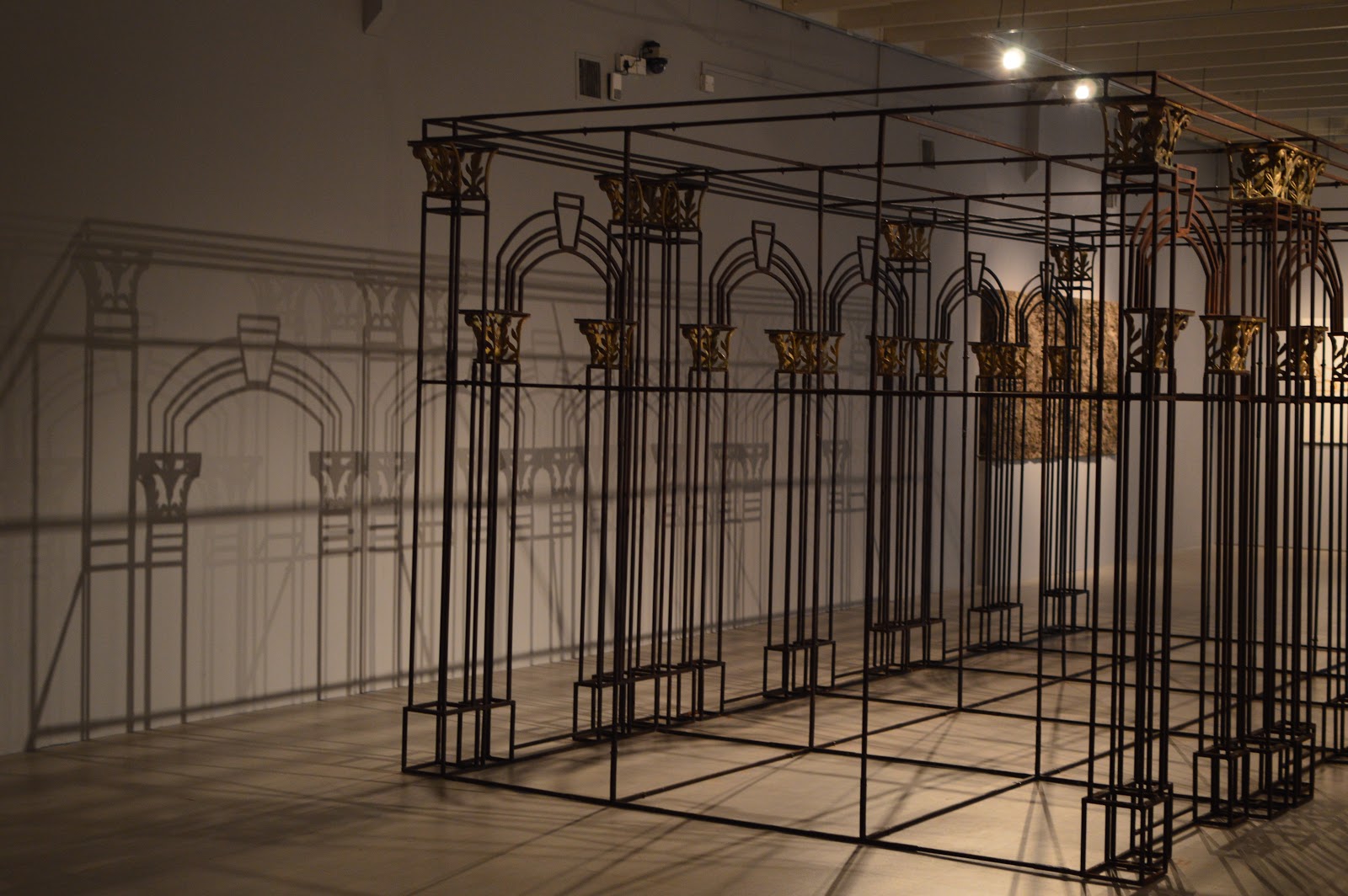

Rathin Barman, Home, and a Home
Home is a place where our dreams and loved ones reside. To the migrant workers toiling far from their families, it is a dream slowly solidifying into reality with each effort they put into work. Barman stays true to their reality, presenting their ideas of home as unfinished and crude creations that carry a shadow of their hopes. We listen to the audio as we observe the shadows cast on the wall, and we were struck by an underlying wistfulness as they complain away, each trying to get closer to the other in an effort to feel a sense of home. He creates a hollow feeling in us as we compare their incomplete efforts to our fully furnished homes and realize the stark contrast of our lives.

What intrigued us most is the way the artist uses rust to create the lines running across this work. While the use of rust in art is unusual, we feel that the medium blends with the symbolism of his works, creating a sense of corrosion over time. Our memories of home and our lives are just like the rust, eroding away in time until reduced to a shadow. In this way we feel for the workers more deeply, the sad irony as their memories of home weaken in their efforts to build one of their dreams. Though each work presents vastly different visuals, there are levels of complexity that creates a unifying message to echo a brand of human empathy as we observe the journeys of these migrant workers.
As we walk away from the museum, one final question comes up in our thoughts: How do we see the world and ourselves? By witnessing the flow of history, dreams and reality, we see and feel the moments of human sentiment that continues to resonate with us in the present day. There are messages that withstand time and illusion, waiting for us to stumble upon and learn from. When we do, we are then placed in a unique position where we can change our worlds and be ourselves, or stumble aimlessly as it progresses on.
Sharmiza Abu Hassan, The Covenant
As we read the synopsis of the next work, we realize the clever shadow play that imbues the darkness lurking in the legend that the work is based on. The legend is familiar to most Singaporean viewers; A man who saved our country from a vicious swordfish attack, only to be murdered by its ruler in return. We feel that the suspended sculpture perfectly casts the metaphor of chaos and confusion that could have ensued from such peril. The throne chair casts an oppressing light onto the ordinary chairs, reflecting the disconcerting balance of hope and dominance in the ruler’s reign. There is a pulsating tension throughout the room, a perfect reflection of the story’s iniquitous ending. Was that the power that the ruler relished when he ordered the hero’s death? Was the murder only an expression of prideful dominance? We are left to wonder at the possibility of conversation between ruler and citizen, and the emotions swirling round the room as the ruler announces his death.
Titarubi, History Repeats Itself
We are instantly taken aback at the ghostly appearance of these hooded figures as we stare into the dark room. Like ornately-dressed messengers of death, they stand sentient atop burnt-out boats, creating an unsettling atmosphere that looms over the installation. Titarubi’s installations is a visual take of Southeast Asia’s colonial history, choosing to focus on the dark realities that the old colonial masters leave in their wake. Nutmeg was an important spice that became a catalyst of numerous wars fought between the colonial masters. By choosing to coat nutmeg seed gold for the cloaks, he displays the meaningless pursuit of riches, a concept that continues to be relevant to us today. The world today still fights for domination, wealth and power, but at what cost? We should have learned from our history, yet we still see such strife in the news and our lives. Are we fated to witness these tragedies forever? The installation fires harsh questions upon our reality, generating an unshakable impact which persists after we leave the room.
Deng Guoyuan, Noah’s Garden II
Stepping into the kaleidoscopic garden is a welcome break from the heaviness created by the previous rooms. Adopting a neon palette, the colors of Guoyuan’s strange plants are strong, sometimes painfully bright to look at under the cool lighting. On closer inspection, we realize the plants to emulate similar depictions in traditional Chinese art. Blending the old and the new together, Guoyuan creates a universe not far from the future, one that incites hope and change, and also skepticism at such a realization. We wonder at the strange beauty of the mirrored gardens that made sense despite the intensity of colors and artificiality of it all. Our futures may appear just like these gardens; appearing as though it is only a dream, yet carrying the hope to realize such a future someday. Visually it makes for a great selfie-shot for young audiences, but we feel the concept to be a little vague, giving much leeway for its viewers to form their own ideas about the installation. The idea of a hopeful future is a great starter for debate, though it could be better if there was a clearer definition as to the kind of future he envisions.
Han Sai Por, Black Forest
We have walked through visions of the past and the future, but the third-floor wing brings us back to reality with a resounding thump. Death is the one event that shocks us to the present, and the moment that all the living can relate to. Han Sai Por brings this to the forefront of our minds in her presentation of a burnt-out forest that spreads across the floor. It is a sight that stirs our consciousness and guilt for the destruction of nature, yet hints a glimmer of hope. The ‘trees’ have not been reduced to dust; they stand resolute, a reminder of the strength of nature that eventually gets the world back on its feet again. The work is a great form of social activism in the way the artist tries to stir a sense of responsibility of the environment, and also tunes our minds to divert back into the present, where these issues require our immediate action. We can go back to the past or forward into our future, but we can go nowhere if we do not embrace our reality.
Adeela Suleman,
Dread Of Not Night 1, 3, 4, 7-9
Blood Stains The Soil 1
At first glance, we notice the stunning ornate patterns adorning the sides of each ceramic plate. However, a closer look had us reeling in shock. Gruesome scenes of violence and massacres become the centerpiece of these plates, a great balance of beauty and horror that perturbs us, but succeeds in drawing us into its macabre world. We find it disconcerting to find such horror designed to mimic beauty; the artist Suleman intended it to be such in order to visualize the concept of sacrifice in the name of momentous beauty. It brings to mind similar scenarios such as the stories of Blood Diamonds, precious stones procured in the midst of war to feed even more wars and conflicts; a ceaseless cycle of violence and beauty. These works are a great example of a branch of conceptual art, posing questions to shake any confident opinions on our morality into retrospection.
Rathin Barman, Home, and a Home
Home is a place where our dreams and loved ones reside. To the migrant workers toiling far from their families, it is a dream slowly solidifying into reality with each effort they put into work. Barman stays true to their reality, presenting their ideas of home as unfinished and crude creations that carry a shadow of their hopes. We listen to the audio as we observe the shadows cast on the wall, and we were struck by an underlying wistfulness as they complain away, each trying to get closer to the other in an effort to feel a sense of home. He creates a hollow feeling in us as we compare their incomplete efforts to our fully furnished homes and realize the stark contrast of our lives.
What intrigued us most is the way the artist uses rust to create the lines running across this work. While the use of rust in art is unusual, we feel that the medium blends with the symbolism of his works, creating a sense of corrosion over time. Our memories of home and our lives are just like the rust, eroding away in time until reduced to a shadow. In this way we feel for the workers more deeply, the sad irony as their memories of home weaken in their efforts to build one of their dreams. Though each work presents vastly different visuals, there are levels of complexity that creates a unifying message to echo a brand of human empathy as we observe the journeys of these migrant workers.
As we walk away from the museum, one final question comes up in our thoughts: How do we see the world and ourselves? By witnessing the flow of history, dreams and reality, we see and feel the moments of human sentiment that continues to resonate with us in the present day. There are messages that withstand time and illusion, waiting for us to stumble upon and learn from. When we do, we are then placed in a unique position where we can change our worlds and be ourselves, or stumble aimlessly as it progresses on.


